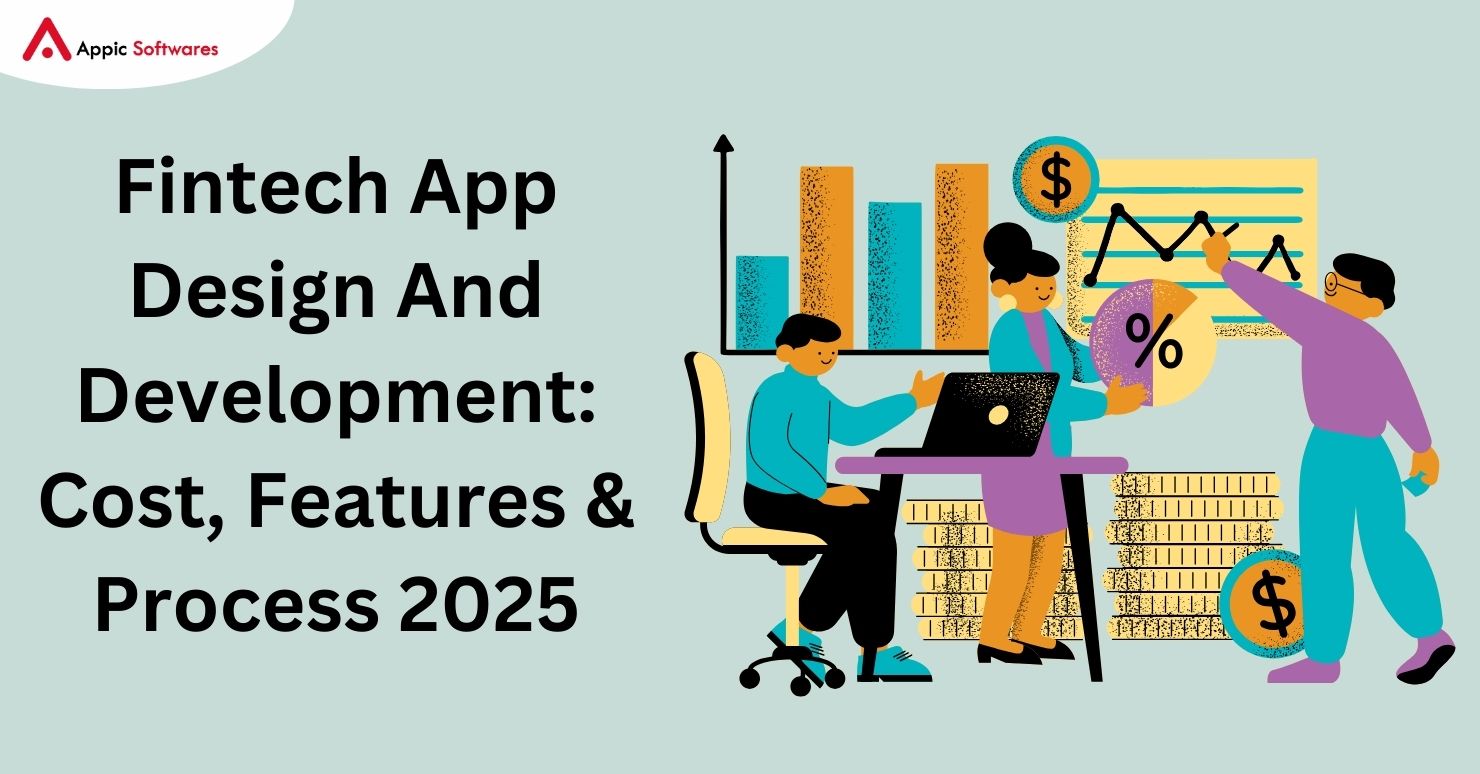Technology touches every part of our economy, from the simplest industries to the most complex ones. One of the key areas where technology makes a big difference is banking. Financial institutions everywhere use app development to make managing money easier and more efficient. New tech trends keep emerging, pushing banking to new heights. FinTech app development is one of the hottest topics right now because it allows for various online payment methods and makes financial transactions smoother. These advancements have opened up fresh opportunities for many companies in the FinTech space.
The financial technology industry is growing fast, with the global fintech market expected to hit $460 billion by 2025. With this rapid growth comes intense competition, making it more important than ever for finance apps to have standout designs. Having a great design isn’t just a bonus anymore; it’s a must-have for success.
A great finance app design should be user-friendly, easy to navigate, and look good. It needs to present information clearly so users can make smart financial decisions. Plus, the app’s branding should be strong and consistent across every interaction.
The best finance apps keep things simple and clean. They use well-chosen colors and typography that work well together, making everything look polished. Consistency is key, and the user interface should feel intuitive. On top of looking great, the app should include practical features that make managing money easy and efficient for users.
Types of FinTech applications
There are different kinds of FinTech apps, each made to simplify how we manage money. Here are some common ones:
- Mobile Banking Apps: These let you do your banking from your phone, like checking your balance, transferring money, or paying bills.
- Payment Apps: Apps like PayPal or Venmo help you send or receive money quickly, pay friends, or make online purchases.
- Investment and Trading Apps: Platforms like Robinhood or Wealthfront allow you to invest in stocks and track your investments easily.
- Personal Finance Apps: Apps such as Mint or YNAB help you manage your budget, keep an eye on your spending, and stay on top of your finances.
- Loan Apps: These apps make borrowing money simpler by connecting you with lenders and making the process faster and more transparent.
- Insurance Apps: Tools like Lemonade let you get insurance and file claims quickly, without the usual paperwork or hassle.
- RegTech Apps: These apps are used by companies to make sure they follow financial rules and regulations and to keep transactions secure.
- Crypto and Blockchain Apps: Apps like Coinbase let you buy and sell cryptocurrencies like Bitcoin, or even store them safely in a digital wallet.
- Robo-Advisors: These are automated services, like Betterment, that help you invest your money based on your goals and risk level, without needing a human advisor.
- Expense and Invoice Apps: Apps like QuickBooks help businesses track expenses, manage invoices, and keep their finances organized.
- Money Transfer Apps: Services like Wise make it easier and cheaper to send money internationally, with lower fees than traditional banks.
FinTech App Development Cost
The future of FinTech in India looks promising, and other countries are also making strides in the FinTech app sector. Developing a FinTech application in India depends on various factors, including the platform requirements and the developer’s cost estimates. Generally, the cost of developing a FinTech app ranges from $20,000 to $80,000, which is an estimate for building a complex financial application with all the necessary features.
FinTech app development services in India is often more affordable due to several factors. Key elements that contribute to the cost of developing these applications include the range of features integrated into the app. Some features that can increase the cost of development include:
Technologies Transforming the Future of FinTech
The FinTech world is changing fast, thanks to new technologies that are transforming how we handle, invest, and manage our money. These innovations are making financial services quicker, safer, and easier for everyone to use. In this blog, we’ll look at some of the key technologies driving this change and how they’re shaping the future of finance to be more efficient and accessible for all.
1. Artificial Intelligence
McKinsey suggests that AI could add up to $1 trillion in value for banks every year. As a result, it’s expected that financial institutions will quickly adopt an AI-first approach to stay ahead of tech companies trying to enter their space.
In fact, according to the Cambridge Center for Alternative Finance, 90% of FinTech companies are already using AI in some way. What makes AI so powerful is its ability to learn and get better over time, performing tasks more quickly, accurately, and efficiently than humans.
AI can analyze data and adapt to it, completing tasks without human involvement. This makes it an ideal solution for the FinTech industry, improving speed, accuracy, and overall efficiency. Let’s take a closer look at how AI is transforming the financial sector.
2. Cloud Computing
Cloud computing boosts security through automated and built-in security features, making it a reliable solution for handling sensitive data. However, it’s important to keep in mind that managing sensitive data always comes with risks, especially with industry regulations in place.
Studies show that cloud data warehouses are more dependable than traditional IT systems. Thanks to features like zero-trust verification and data encryption, the cloud offers better protection against fraud and data breaches.
Cloud technology is changing the way we live and work. It helps businesses make the most of digital transformation by enabling secure data sharing and supporting dynamic applications. This technology is adaptable to any industry or department, making it a versatile tool for businesses no matter their focus.
Additionally, the global FinTech sector is expected to reach a market size of USD 124.3 billion by 2025, growing at a rate of 23.84% annually, according to research by Global Newswire. Now, let’s explore some of the key use cases of cloud computing in the industry.
3. Blockchain
Blockchain has the potential to completely change the way banking works. With distributed ledger technology (DLT), data can be shared and updated in real time across multiple systems, making it more efficient and secure.
Blockchain helps solve several issues faced by traditional financial systems, such as dependence on centralized systems, trust issues, high costs, and risks from single points of failure. By addressing these problems, blockchain can improve revenue, streamline processes, and reduce business risks.
The rise of blockchain has also attracted more investors, including large financial institutions, looking to take advantage of its benefits. Many FinTech companies are hiring blockchain experts to integrate this technology into their solutions. Blockchain isn’t just limited to finance either; it’s also making waves in industries like real estate. In real estate, blockchain can improve security, simplify property transactions, and ensure clear ownership records.
As interest in blockchain grows, more companies across different industries are adopting it to improve their operations and offer better services.
4. IoT
The Internet of Things (IoT) is a network of physical objects equipped with sensors, software, and other technologies that allow them to connect to other devices and systems via the Internet, sharing data in real time.
The finance sector was one of the first to embrace digital transformation, with real-time data playing a crucial role in its operations. To meet the demands for instant data access and analysis, the industry has integrated IoT and real-time analytics.
Today, it’s hard to imagine our lives without the power of analytics, which helps businesses understand customer behavior by analyzing their purchasing patterns. In finance, IoT helps gather valuable data about clients and automates tasks like fraud detection, reducing the need for human intervention.
Moreover, IoT provides a secure platform for data protection and has several other applications in the financial industry. Investors, insurers, and other financial professionals are increasingly using IoT to assess risks, improve customer engagement, and streamline complex processes like claims management.
5. Low Code/No Code
Low-code programming allows you to create software using a visual interface rather than writing code by hand. Instead of manually coding, you simply use visual elements to represent the code and drag and drop them to build the system. This approach can make software development faster and more efficient.
Low-code platforms enable businesses to quickly adapt to changing needs since users can build and modify their systems without waiting for professional developers to make changes.
Additionally, low-code and no-code applications are often more cost-effective than traditional in-house systems. According to Grand View Research, the global market for low-code application development platforms is expected to grow at a compound annual growth rate (CAGR) of 22.7% from 2022 to 2027.
For larger banks serving millions of customers, adopting no-code solutions will be essential for staying competitive. It will allow them to quickly create new products or applications, sometimes in just a few days, helping them keep up with the fast pace of the industry.
6. Open Source and SaaS
The foundation of financial innovation in today’s digital economy is built on scalability and performance. Over recent years, open-source architecture and software-as-a-service (SaaS) solutions have become crucial elements of the FinTech industry, playing a key role in the digital transformation of financial services. If you’re curious about how financial services are embracing this digital shift, check out our blog for more insights!
SaaS makes it possible to access software online as a service, meaning you no longer need to install and maintain it yourself. This also means you don’t have to worry about managing complex hardware and software.
By using cloud-based technology instead of downloading and storing software locally, businesses can stay agile and competitive. Since SaaS platforms are regularly updated, financial institutions can take full advantage of the latest technology advancements, ensuring they stay ahead with FinTech innovations.
7. Open APIs
Open banking is transforming the way people interact with financial services, making open APIs and services more common in the process.
By analyzing data from various sources, financial service providers can use open banking to offer personalized services to their clients. These APIs play a key role in creating seamless user experiences and ensuring data security through protected endpoints.
Open banking is also a regulatory framework designed to promote competition among banks, encouraging them to offer better services to customers. It’s important because it gives customers more control over their data.
Additionally, open banking allows users to access a broader range of services from different providers, which boosts competition and can lead to better prices for consumers.
8. Robotics
Robotics engineering is a field focused on designing, creating, and using robots to perform various tasks. The main goal of this technology is to build intelligent machines that can assist humans in different ways.
Robots can come in many forms, from humanoid models to software-driven robotic applications. These robots work with humans to carry out different activities, often in collaboration with software.
In industries like banking, robotics technology is used through robotic process automation (RPA), which involves specialized software and tools that automate tasks based on specific requirements. Today, financial institutions use robotics for tasks such as opening accounts, handling customer inquiries, and automating other repetitive processes.
9. Machine Learning
How can I hire a dedicated FlutterFlow developer?
FlutterFlow is a visual app development platform based on the Flutter framework, allowing users to build applications through a drag-and-drop interface with minimal coding. It’s particularly useful for creating cross-platform apps, integrating custom code, and connecting with Firebase for backend support, making it ideal for faster, more accessible app development.
To hire a dedicated FlutterFlow developer, it’s important to know what skills and services to look for. A skilled FlutterFlow developer should be able to handle front-end design, backend integration, Firebase setup, and custom functionality for your app. Full-stack expertise in FlutterFlow means they can also manage user authentication, and data handling, and create responsive app designs. To hire Flutterflow developers it should be comfortable with both technical and UI aspects, ensuring your app is visually appealing and user-friendly.
When I needed a FlutterFlow developer for my project, I prioritized a few essential traits:
- Strong knowledge of Flutter and Firebase,
- Experience in API integration and building complex, intuitive UI designs,
- Problem-solving skills focused on creating seamless user experiences, and
- Clear communication skills for understanding and implementing project needs.
After evaluating several options, I found Appic Softwares, a mobile app development services known for its reliable app developers. If you are looking to develop a mobile app with Flutterflow you can hire a developer through them, and their expertise helped your project progress smoothly, with high-quality results delivered on time. To know more visit their website!











